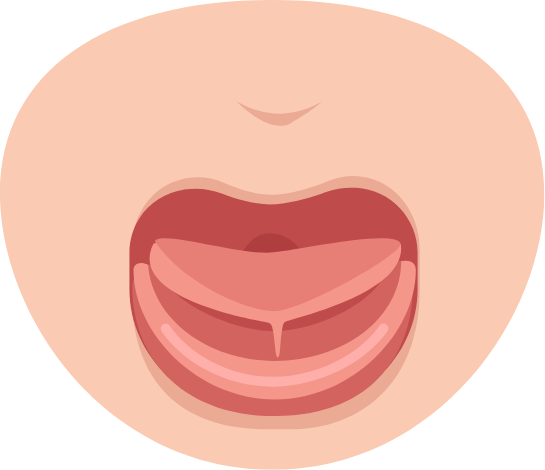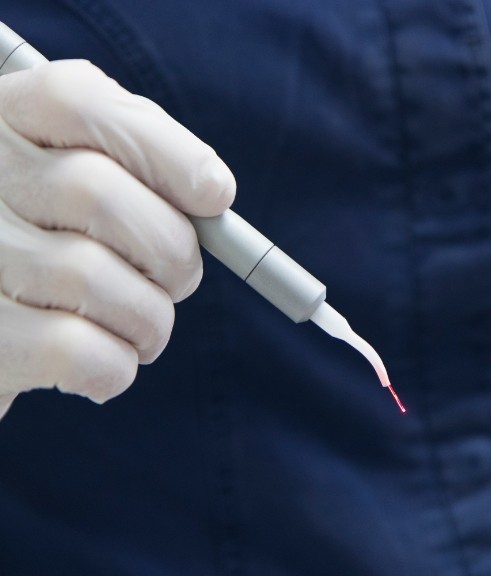Lip & Tongue Tie Solutions – Hamilton, ON
Helping Children Thrive with Restored Oral Function
Lip and tongue ties can impact patients of all ages but because they develop in utero, parents most often notice signs in infants and children as they nurse and start to develop new skills, like eating solid foods and speaking. Our team can help regain mobility of you or your child’s lips and tongue to improve overall quality of life and comfort. Call us today to learn more about this condition and how to get it treated with our lip and tongue-tie solutions.
Why Choose Hamilton Lip & Tongue-Tie Center for Lip & Tongue Tie Treatment?
 We Use a Team Approach to Maximize Treatment Outcomes
We Use a Team Approach to Maximize Treatment Outcomes Ethical Care: Not Every Tie Needs to Be Released
Ethical Care: Not Every Tie Needs to Be Released An Experienced & Knowledgeable Pediatric Dentist
An Experienced & Knowledgeable Pediatric Dentist
What Is a Lip Tie?

In utero, the complex systems of the body begin to grow and develop, including major organs, fingernails, eyelashes, and something that may not have even crossed your mind—small bands of oral tissues called frenulum. These connect the lips to the gums, but sometimes can develop too short or thick and restrict their movement, making basic tasks like eating, speaking, and even breathing more difficult. This is called a lip tie.
What Is a Tongue Tie?

Just like a lip tie, a tongue tie develops in utero. However, instead of referring to bands of skin that connects the lips to the gums, a tongue tie affects the frenum that connects the tongue to the floor of the mouth. When the tissue is overgrown or too long, it can restrict the tongue’s movement, impacting your child’s ability to properly chew and digest foods as well as effectively nurse.
Symptoms of Lip & Tongue Ties

Lip and tongue tie symptoms often overlap, so we encourage parents to look out for any of the most common signs. These can include:
- Pain while breastfeeding
- Fussiness as a result of digestion issues
- Slow weight gain
- Aversion to certain foods
- Speech impediments
- Mouth breathing or snoring
- Gaps between teeth
- An increased risk of cavities
If you notice one or more of these symptoms and believe they could be the result of a lip or tongue tie, we encourage you to schedule a consultation with us!
Learn More About the Symptoms of Lip & Tongue Ties
What Is a Frenectomy?

A frenectomy is a minor surgical treatment that we use to address lip and tongue ties. Before you can schedule this procedure, you will need to have your child examined by Dr. Rullo to make sure that it’s necessary. In certain situations, our team may recommend therapy to improve oral movement. However, if a frenectomy is necessary, Dr. Rullo will use a laser to precisely and more comfortably remove any overgrown tissue.
Learn More About Frenectomies & Frenotomies
Lip and Tongue-Tie FAQs
Is my child old enough to get a lip or tongue tie treatment?
When it comes to performing lip or tongue tie treatment on a child, there is no age minimum. It may seem hard for parents to think about their baby undergoing a laser frenectomy, but the truth is that this type of procedure is safe and quick and can even be completed just days after birth. Since these banded tissues will not simply “go away,” it’s best to seek treatment right away instead of waiting. The quicker our team can remedy the issue, the greater the chances your baby will begin to experience improved oral function.
Can I be in the room during my child’s frenectomy?
It depends on the specialist, but generally, it’s recommended that parents do not be in the room during their child’s procedure. This can be hard, and we understand that; however, because our focus needs to be on the needs of the patient, we find it best that parents wait outside to avoid any possible uneasiness or distraction. This can make an otherwise quick process take much longer. As soon as the procedure is complete, though, you are more than welcome to return to the treatment room to be with their child.
Are there diet restrictions after a frenectomy?
If a frenectomy is performed on an infant, there will be no change to their diet, as breastmilk or formula are fine. If the procedure is necessary for older babies, children, or adults, it will be necessary to remember that no food should be consumed until the effects of anesthesia wear off (if it is used). In the 1-2 days following their frenectomy, it will be best for them to avoid hot, cold, acidic, spicy, or salty foods, as these can irritate the treated tissue, making it harder for the area to heal properly.
What are the benefits of a laser frenectomy over a traditional frenectomy?
Many dentists are turning to newer equipment and technologies to perform frenectomies. At our office, we are pleased to create less stressful experiences by using a dental laser to complete these procedures. Traditional frenectomies use a surgical scalpel and scissors, but laser frenectomies rely on a customized device that consists of a concentrated beam of light that is used for greater precision. When performing a frenectomy, the laser’s accuracy allows for reduced bleeding and swelling, and it cauterizes the tissue during the process. This allows for faster healing as opposed to a lengthier recovery one might require after undergoing a traditional frenectomy.

